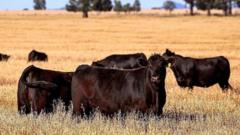Will Australia Finally Lift the Import Ban on US Beef After Trump’s Tariffs?

Australia Lifts Beef Import Restrictions from the U.S.: What You Need to Know
The recent decision by the Australian government to lift restrictions on the import of beef from the United States marks a significant change in trade relations. This move has been highly anticipated, particularly in the context of ongoing discussions about tariffs and trade barriers. With Australia known for its stringent biosecurity laws, the lifting of this ban has raised questions and concerns among various stakeholders. This article delves into the implications of this decision, the history behind the restrictions, and what it means for consumers and the beef industry in both countries.
The Historical Context of Beef Import Restrictions
The restrictions on American beef imports into Australia have been in place since 2003, primarily due to concerns over bovine spongiform encephalopathy (BSE), commonly referred to as mad cow disease. This disease raised significant alarm globally, prompting countries to enact strict measures to protect their livestock and consumers. Australia's biosecurity laws are among the strictest in the world, aimed at preventing any potential outbreaks that could harm the local cattle population.
During this period, the Australian government maintained a firm stance on its biosecurity protocols, despite pressure from various international trade partners, including the United States. The ban on U.S. beef became a point of contention, particularly during the Trump administration, which viewed it as an unfair trade barrier.
The Recent Changes: What Prompted the Lifting of Restrictions?
The Australian government's recent decision to lift the ban stems from a decade-long review conducted by its agriculture department. This review concluded that the U.S. had significantly improved its beef production safety measures, particularly in terms of cattle tracing protocols. These protocols allow authorities to effectively track cattle from their origin to the point of sale, ensuring accountability in the event of a disease outbreak.
Australia's Agriculture Minister, Julie Collins, emphasized that the decision was based on rigorous scientific analysis and a thorough risk assessment. She stated, "This decision has been purely based on science," reiterating the government's commitment to maintaining biosecurity standards while also recognizing the importance of international trade.
Trade Relations: The Impact of U.S.-Australia Beef Trade
Australia's beef trade with the United States is significant, valued at approximately A$14 billion (around $9.2 billion) last year. The U.S. stands as Australia's largest beef export market, making it crucial for Australia to maintain a robust trading relationship. The lifting of the beef import restrictions is expected to enhance this relationship further, allowing for greater market access and potentially increasing the volume of beef traded between the two nations.
Despite concerns from opposition parties regarding the timing of this decision, industry leaders have largely welcomed the move. Will Evans, Chief Executive of Cattle Australia, expressed comfort with the decision, noting the importance of faith in the department's scientific assessments. He underscored the need for a positive relationship with the U.S., especially considering its role as a vital trading partner.
Domestic Reactions: Support and Opposition
While some industry leaders celebrate the decision, not everyone is on board. Critics, including members of the opposition, have expressed concern that lifting the ban may have been a concession to appease the Trump administration. Nationals leader David Littleproud voiced skepticism, stating, "It looks as though [the ban has] been traded away to appease Donald Trump, and that's what we don't want." This sentiment reflects fears that the government's approach to biosecurity could be compromised for the sake of trade negotiations.
This division in opinion highlights the delicate balance that the Australian government must maintain between ensuring biosecurity and fostering international trade relationships. With the ever-evolving landscape of global trade, the ramifications of such decisions can be far-reaching.
What Does This Mean for Consumers?
For consumers, the lifting of the beef import ban presents both opportunities and challenges. On one hand, increased access to U.S. beef could lead to greater variety and potentially lower prices in the market. On the other hand, concerns about biosecurity and food safety remain paramount. Consumers may wonder how this decision will impact the quality and safety of beef products available in Australia.
As the market adjusts to this new reality, it will be essential for consumers to stay informed about the origin and safety of the beef they purchase. Transparency from producers and retailers will play a crucial role in maintaining consumer confidence in the beef supply chain.
The Future of U.S.-Australia Beef Trade
Looking ahead, the future of U.S.-Australia beef trade appears promising. The lifting of import restrictions opens the door for increased collaboration between the two nations. This collaboration could lead to advancements in beef production practices, shared research initiatives, and improved biosecurity measures.
Moreover, with the introduction of better cattle tracing protocols in the U.S., Australia can feel more confident in the safety of imported beef. This could pave the way for other countries with similar restrictions to reconsider their positions, potentially leading to a broader re-engagement in global beef trade.
FAQs on Australia's Beef Import Restrictions
Why were beef imports from the U.S. banned in the first place?
The ban was implemented in 2003 due to concerns over mad cow disease (BSE) outbreaks in cattle, which raised significant biosecurity concerns for Australia's livestock industry.
What improvements have been made in U.S. beef safety measures?
The U.S. has introduced enhanced cattle tracing protocols, allowing for better tracking of cattle from their origin to market, which helps mitigate the risk of disease outbreaks.
How will this decision impact Australian consumers?
Consumers may see an increase in the variety of beef available and potentially lower prices. However, concerns about biosecurity and food safety will remain important for consumers to consider.
What are the potential benefits of lifting the ban?
Benefits include increased trade volume between the U.S. and Australia, potential economic growth in the beef industry, and improved collaboration on beef production practices.
What challenges could arise from this decision?
Challenges may include public concerns over food safety, potential pushback from local producers worried about competition, and the need to maintain strict biosecurity standards.
Conclusion: A New Era for U.S.-Australia Beef Trade
The lifting of beef import restrictions from the United States signifies a pivotal moment in international trade relations for Australia. As both nations navigate this new landscape, the focus will need to remain on maintaining high standards of biosecurity while fostering economic growth. The implications of this decision will be closely monitored by industry leaders, consumers, and policymakers alike.
As we move forward, it will be interesting to see how this change impacts the broader agricultural landscape and whether it leads to further shifts in trade policies worldwide. Can Australia balance its biosecurity needs with the demands of international trade? Only time will tell.
#AustraliaBeef #USTrade #Biosecurity
Published: 2025-07-24 01:50:07 | Category: technology



